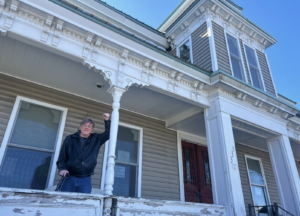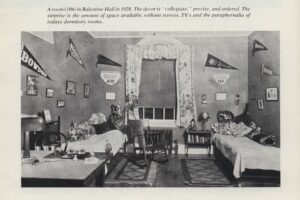
As you walk by the University Mall, your eyes might catch a glimpse of a vivid photograph inside Lord Hall. A picture of fall foliage behind a brick building is hung up adjacent to the window that overlooks University of Maine students rushing to class every morning.
Works of Heath Paley, a distinguished Portland-based photographer, are on display at the Lord Hall Gallery from July 22 through Sept. 23. On Friday, Sept. 9, there was an Artist’s Reception at the gallery. Titled “Picturing Downtown Maine” this exhibition walks you from the busy streets of Portland to colorful corners of Lewiston. Twenty-six photographs taken in 18 different towns of Maine, including Bangor, were printed on metal. Therefore, there is no glass that separates you from the photograph.
“I am not practicing journalistic photography,” Paley said. Staged photos, or photos where certain elements are removed or altered by photoshop, are considered unethical in the photojournalistic field.
“It is an artistic decision, trying to create the truth of that picture. Like writing a novel, it is a melding of your experience with god knows what,” Paley shared.
Paley’s unique technique creates an eye-catching result. One can tell that Paley’s photographs are not your usual one-shot pictures. If Paley is interested in a particular scene, let’s say a building, he will take sixteen overlapping pictures of that same building. That way, Paley can choose what he wants to include or exclude in the picture. For example, if a trash can seems unfitting in front of the building, Paley can move the trash can, and take the shot without it in the frame. However, some might argue that manipulating the shot, whether it is on the scene or back in the studio, takes away the authenticity of a photograph.
After taking numerous overlapping shots of the same scene, Paley then pieces them together in his studio. He creates layers, straightens up the lines, enhances colors, and so much more in order to get a final picture. Depending on the complexity and number of shots, that meticulous process can take anywhere from 45 minutes to several weeks. Because of their size, it can take 10 minutes for pictures to load onto Paley’s laptop computer.
“Photography is not an inexpensive topic and it is time consuming,” Paley explained.
“If people get excited about doing photography, they should do it and they will figure out a way to do it.”
Paley’s photographs have a distinctive vividness to them because you are seeing the image in the way your eyes would see that scene in real life.
“If I was shooting with one shot, I’d have to focus on something and the rest would be blurred. Your eyes don’t see things like that,” Paley explained. “Most of photographers think that out-of-focus gives depth, but that’s not how it is. By bringing the background up-close, that’s how you create depth.”
By shooting multiple shots, Paley is able to expand the space and draw the viewer into the space. At the reception, some people kept returning to previous photographs they saw, as if they were taking a second look at those images.
“I am trying to figure out which layer is the first, second or third photograph,” Christiana Becker, a studio art and art education student, shared. “Sometimes I feel like it could be one photo. I want to know which [layer] is which because it is like a puzzle.”
Lord Hall Gallery curator Laurie Hicks is glad that people want to take a second look at Paley’s work. “Spending more time to look at the picture brings them [viewers] closer to photographs; not just physically but conceptually,” Hicks said.
This exhibition was first shown in Augusta at the Maine State House from April 18 through July 10. Hicks was planning the Lord Hall exhibition in association with the Maine Arts Commission for a year and a half. When she saw Paley’s images for the first time, she was immediately interested in them.
“For me that is the first step,” Hicks said. “Am I interested, am I challenged, do they draw me back in?”
There were times when Paley took hundreds of frames of a particular scene. He can spend hours waiting and shooting photos in order to capture the perfect moment.
“You get a feel for the place and know when the right person walks in,” Paley shared. “You have to be in the right place in the right time to get this result.”
Paley has been practicing the mergers technique of photography for over ten years, and is still perfecting it.
“Hopefully, you are always learning,” Paley said. “If not, it’s not that fun or exciting to do. People tend to think of artists as being inspired, and all of a sudden magically doing stuff. There is a lot of inspiration involved, however, being an artist is about ninety percent hard work and ten percent inspiration.”
Third-year art education student Emily Michaud shared that she truly enjoyed each piece at the exhibition.
“It is like looking at a moment in time that’s been frozen. It captures the richness of our world around us,” Michaud explained. “I think it’s hard to recognize that richness of what we’re seeing when we’re always moving, and constantly having to be somewhere and do something. But when you pause and you look at something, it really is quite beautiful.”









